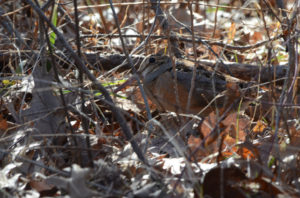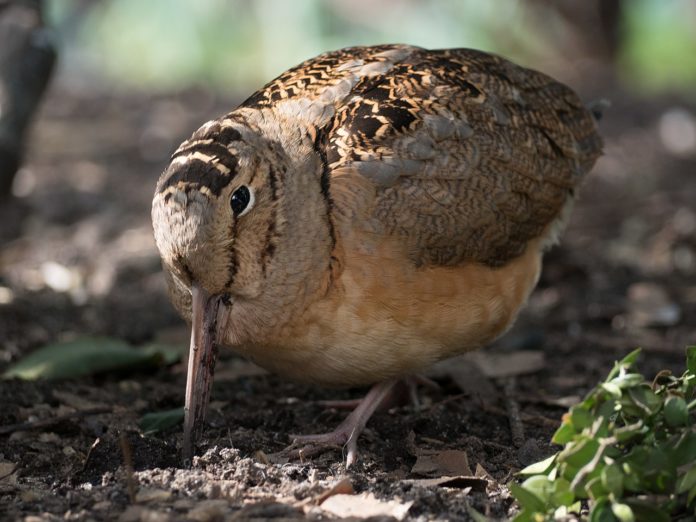By Larry Cornelis – Sydenham Field Naturalists
Well, they are one and the same.
You probably know their more common name, the American Woodcock.
A couple of other strange and wonderful names are Hokumpoke and Labrador Twister.
The American Woodcock (Scolopax minor) is a strange and wonderful bird.
Technically a shorebird, but it lives in brushy areas, open woods, young forested habitats, tree plantations and sometimes marshy wet thickets.

They are excellently coloured to be well camouflaged on the ground among leaves and branches.
They are very difficult to see and usually you will be extremely startled as one explodes into flight right in front of you, practically under foot.
They have stout rotund bodies and very long bills (for probing into the soil searching for food).
Their bill is prehensile which allows the upper bill tip to flex/open and close, allowing the bird to grab worms and other invertebrates in the soil.
The underside of the upper bill and the tongue are rough-surfaced to grasp food.
They have large eyes that are located high on the head which gives them a 360-degree view, more than any other bird.
Woodcocks are crepuscular (relating to twilight) therefore are active at dusk and dawn and on full moon nights.
One of the wonderful behaviours of the woodcock is the courtship display/flight of the male as he tries to attract a mate.
This starts with the male strutting around in an open grassy area where he makes a call referred to as a peent.
He repeats the peent call over and over which is followed by a flight of up to 100 yards high, followed by a swirling circling descent with loud twittering chirps and bubbly sounds created by the primary wing feathers.
It’s a remarkable sky dance of crazy sounds.
He then lands right back where it all started and he starts peenting again and repeats the whole show.
This amazing courtship flight is a welcomed sign of spring.
Sometimes you find leks, meaning there are several males doing this close together.
Woodcocks migrate back to our region in early March.
Now is a great time to see and hear them.
I went out this week to watch and hear the woodcocks doing their thing at the Darcy McKeough Dam.
I would really miss the annual show if I didn’t see it every spring.
Males do not participate in nest building, incubating, or raising young.
That’s all for the female to do.
Usually, four eggs are laid in a slight depression on the ground.
The young are precocial, walking from the nest in hours and begin flying at a very early age, two to three weeks, while much smaller than their parents.
I find it surprising to see these pint-sized young birds flying.
Woodcocks also do a weird walk.
They move their body back and forth (head to tail) and then sneak in a step.
They progress very slowly.
It’s like an avian version of walking like an Egyptian.
It’s rather funny to watch.
Woodcock populations are declining.
And sadly, (in my opinion) over half a million are shot annually by hunters as a game bird.
This practice, habitat loss and climate change are factors in the declining numbers.
We may lose this wonderful bird in our region as it’s range shifts to the north due to climate change and warming temperatures according to authorities.
The males carry on with their courtship flights well into May so there is still plenty of opportunity for you to catch the display this spring.
Find an open grassy area with some trees or near a woodland and start about 10 minutes before sunset on a calm evening.
I hope you enjoy this harbinger of spring.
For more details, visit: http://www.sydenhamfieldnaturalists.ca/
– Photo credit: Rhododendrites
– Photo license, here.
















